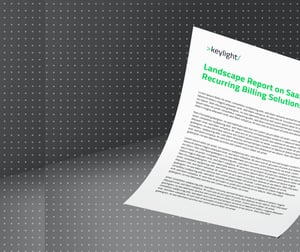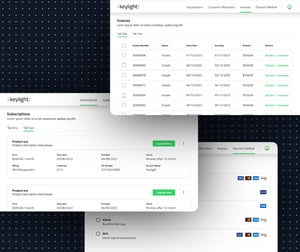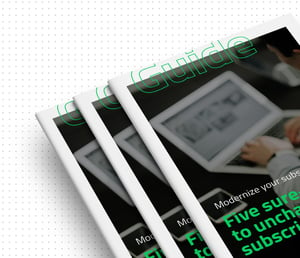Sustainable business models
Subscriptions and the circular economy
Being proactively sustainable as a business is more important than ever. To put a number on it, in an aptly titled report called "Consumers care about sustainability—and back it up with their wallets", this year, McKinsey said: "more than 60% of respondents said they’d pay more for a product with sustainable packaging." Amongst their other compelling metrics, they also wrote: "Products making ESG-related claims averaged 28 percent cumulative growth over the past five-year period, versus 20 percent for products that made no such claims."
Switching to or adding a subscription component to your business is a sustainable way to be part of the circular economy whilst adding a powerful revenue stream, appealing commercially and ethically to your customers.
The circular economy
What is product-as-a-service?
While recyclable packaging, reduced energy consumption and so forth are all valiant efforts in the bid for improved commercial sustainability, true circularity is the gold standard of environmentalism. Proactively reducing waste and limiting the additional use of finite resources is the ultimate goal.
The European Parliament says: "The circular economy is a model of production and consumption, which involves sharing, leasing, reusing, repairing, refurbishing and recycling existing materials and products as long as possible. In this way, the life cycle of products is extended."
The Ellen MacArthur Foundation says: "The circular economy tackles climate change and other global challenges, like biodiversity loss, waste, and pollution, by decoupling economic activity from the consumption of finite resources."
When it comes to the circular economy and product-as-a-service specifically, it's where products are taken by consumers and they pay for the time of usage while the provider typically retains ownership throughout its lifecycle. They manage the product through design, usage, maintenance, reuse, remanufacture and recycling.
Service sustainability
Meeting evolving customer expectations and ethical standards
Circularity is particularly prevalent in the retail sector, but across the board we know that this is the way more and more people are engaging with products and services of all types. Financially, all businesses have an opportunity in this space.
Those who are doing it best have recognized an intersection between:
- Customer needs that are not being optimally served by purchasing items outright.
- Customers' ethical values which are not being suitable served by traditional purchasing solutions.
- Products that require repeat usage and often necessitate high upfront costs, costly maintenance or repair and frequent upgrades over the course of the customer's lifetime.
Standing out in the market are the likes of StrollMe, who rent baby products including prams and high chairs; Rent the Runway for borrowing designer clothing; DeviceNow who provide ready-to-use IT for companies; and BlueMovement who rent home appliances on a subscription basis.
Success hinges on fully understanding the fundamental pillars that shape the structure of the business model
A genuine mission for the environment
Reflecting both the social and natural environment, product catalogs need to provide a rich offering and engage customers with the right measures in time.
Understanding what continuity of the
customer relationship looks like
Businesses understand that customers are conscious about their choices and expect a good experience to be smooth and effortless at every touch point.
Commitment to the product lifestyle
Businesses need to make the user experience as flexible as possible, from fulfillment to upgrades, downgrades and pausing the service. This requires a system built to provide the relevant data to understand and engage customers on an ongoing basis.
Business strategy
How to execute the circular business opportunity
By setting out to offer a subscription product or service, you're already ahead of the game when it comes to creating a business that's proactively circular in its approach. Consolidating that intention comes in how you execute your vision by effectively and sustainably managing customer relationships and subscriptions.
Even customers with the most staunch environmental values will not remain loyal to a business of any type if the service and delivery is not done well. In subscription businesses, this hinges on how you set up your platform both today and making provision for how it will evolve in the future.
Getting this right manifests in four key areas below.
Capturing service value
Convenience, flexibility and experience are the hallmarks of a good subscription business as far as the user is concerned. These are difficult attributes to quantify.
For example, value doesn't necessarily mean cheaper than the alternative, but it does mean delivering an experience that's worth paying a bit more for if necessary. Ultimately, these three things boil down to solving a problem or providing a solution in the customer's life, and making the process so seamless and trouble free it's enjoyable.
That means a clear proposition, great service, easy-to-use platforms and dependability. Practically, that means that you need a system that supports the user from one end to the other, for example, delivering streamlined fulfillment and billing processes without having to be asked twice.
Product catalog and pricing automation
Pricing is an essential part of any business success—that doesn't mean being the cheapest but it does mean providing value and justifying the fee. It also means getting the pricing right so that it's realistically something your target market will be able to retain. It's not just about the initial cost either—over time, prices will increase, offers may be applied, people will upgrade and downgrade their service, and so forth.
Getting this right requires a system that's smart enough to make good decisions and with space to provide promotions. A smart subscription management and billing platform must automate price offerings for new and used products, enable voucher codes and automate customer promotions. All this needs to intersect with a product catalog that can handle physical and digital products, as well as bundles, whilst remaining manageable at scale.
Inventory and contract management
It sounds obvious, but when customers subscribe to your business, your system needs to keep track of things so they don't need to follow it up, making sure they get the right item, and are billed for the correct amount. As your relationship with your customer evolves, that's not always as easy as it sounds. Your system needs to know when to start billing, when to ship the product and when the customer receives/returns it—all little processes that go into that need to be streamlined between systems that communicate with one another effectively. The key to that is an API-first approach that can easily push or synchronize data between fulfillment and ERP systems, and capture the right events for contract and billing management.
Subscription events and customer insights
A fundamental attribute of subscription businesses is they’re about constant learning and evolution. The technology evolves, the market evolves, your customer evolves, and so too does your relationship with them, influenced by all these factors and more.
The customer experience with you is the foundation on which their bond and commitment is built, and continuing to nurture that means having a constant "dialogue" with them. In the digital age, that dialogue is defined not only by verbal feedback but by all manner of data so that you can constantly observe, understand and adapt for your customers' behaviors.
For this, your system needs to enable end-to-end data capture, where customer subscription activities need to be accurately presented to your team so that customer engagement can be achieved in a timely manner (preferably instantly, which is what we offer with our future-scoping Prospective Business Engine).
The future is now
The power of the right subscription platform
All these things and more are the essence of delivering on both the commercial needs of a subscription business and truly honoring environmental commitments. Traditional commerce platforms are built to provide an initial product purchase extremely well, but they simply can't handle subscription knowledge effectively. When a customer comes to upgrade, downgrade or go to the next stage of their relationship with you, the system can't cope, you lose both visibility of what's happening, and most likely the customer relationship as well.
For all involved, it's essential that you keep track of subscription activities within your business, especially if you're to truly be part of the circular economy, and that's where keylight supports you in all your values and functionalities. Managing recurring business processes, customer self-service, billing, a scaling product catalog, automation, structured data, the customer relationship and the long-term evolution of your business is built into keylight's DNA.
keylight is both the commercial and environmental choice of the future. See for yourself!

Power your business
with the right subscription solutions
![]() Book a free consultation
Book a free consultation
Power your business
with the right subscription solutions
![]() Book a free consultation
Book a free consultation

Explore keylight's superior value compared to conventional subscription platforms
![]() Compare now
Compare now
Explore keylight's superior value compared to conventional subscription platforms
![]() Compare now
Compare now




